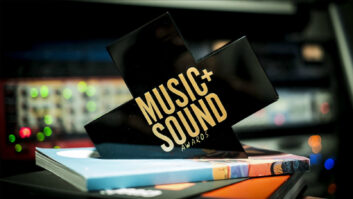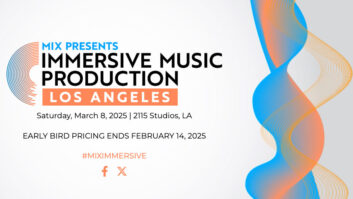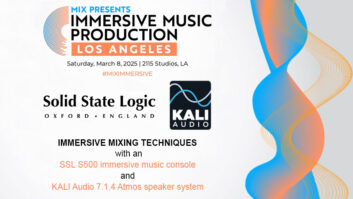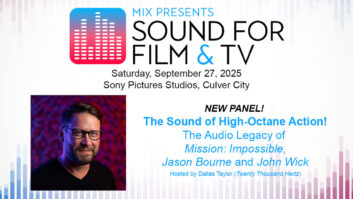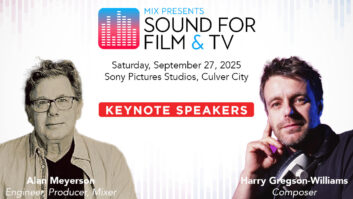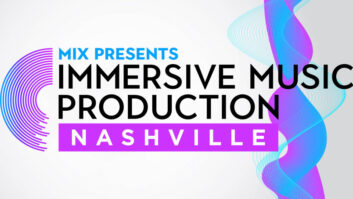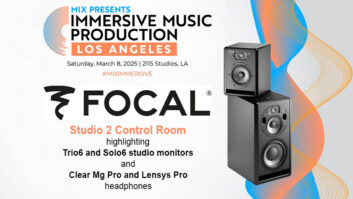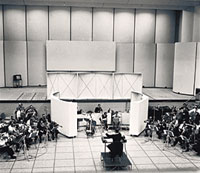
Conducting the Ennio Morricone Orchestra in RCA Studio A, Rome, in 1965.
Photo: From the book C’era una volta la RCA by M. Becker, courtesy of Coniglio Editore
Watching Ennio Morricone receive his Honorary Award for “magnificent and multifaceted contributions to the art of film music” at the 79th Academy Awards ceremony in February 2007, viewers were able to grasp in his speech (which was translated by Clint Eastwood) the humble, down-to-earth nature of one of cinema’s most inventive and original composers.
Morricone’s career dates back to 1961, when, a few years after obtaining diplomas in trumpet and composition at Rome’s Santa Cecilia Conservatory, he began working on music for A Fistful of Dollars (1964), the first of a series of legendary Western soundtracks for Sergio Leone. During an almost 50-year career, Morricone has scored more than 400 films, working with many of the world’s top directors. His best-known soundtracks include The Battle of Algiers, The Good, the Bad and the Ugly, Sacco and Vanzetti, Cinema Paradiso, The Legend of 1900, Malena, The Untouchables, Once Upon a Time in America, The Mission and U-Turn. Apart from his ex-schoolmate Leone, his illustrious clients have included filmmakers such as Gillo Pontecorvo, Pier Paolo Pasolini, Bernardo Bertolucci, Giuliano Montaldo, Giuseppe Tornatore, Brian De Palma, Roman Polanski, Warren Beatty, Oliver Stone, Margarethe von Trotta, Henri Verneuil, Pedro Almodóvar and Roland Joffé.
“The film’s director is my client and is the person who contacts me,” says Morricone, 80, from the home in Rome where he does all his writing. “There are various ways of going about the job. Sometimes I discuss the film with the director or he gives me the script to read; on other occasions, I view the first edit, the dailies or the final cut, and when I’ve got clear ideas I meet for discussions with the director and submit my ideas. I have a very close relationship with the directors I work with. Their collaboration is very important, but they must put their complete trust in the composer: Some directors have very clear, sometimes restrictive, ideas on what they want from a musical point of view, which limits composers’ creativity.”
The Composer’s Approach
The average viewer might imagine that when a composer hasn’t seen the edited film but only read the script, he might begin by writing the main theme, but Morricone says that this is not always the case: “Every film has a characteristic feature, which can be suggested by the director or ‘felt’ by the composer. This characteristic must remain, and the music is born from that certain feel, typical feature or style that the composer grasps. Each composer reacts personally to the film’s action and style — the director’s ‘poetics,’ the images, story and key sequences or scenes. So, in theory, 10 composers will write 10 totally different scores for the same film and they could all be good — if the composers are.”
Another commonplace notion refuted by Morricone is that a composer’s approach varies according to the type of film — a love story, an action movie, a Western, etc. “My personal approach is always the same,” he says, “but it could vary, for example, if the director gives the composer carte blanche or is restrictive as far as music is concerned.”
He notes that the time he needs to score a feature will vary according to the amount of music in each film, adding that it also “depends a lot on the period of reflection required: In some cases, I have a very clear idea of what to do almost as soon as I see a film, whereas in others a lengthy period of thought may be required. However, when I’ve got clear ideas and am in agreement with the director, it might take two or three weeks — even just 10 days!”
The Score in the Studio
Morricone stresses the particular importance of his working relationship with studio sound engineers. “I met [the late] Franco Patrignani at RCA’s Rome studios on Via Tiburtina many years ago, and we had a great, friendly relationship. This is a must with the technicians with whom I work because their job is of fundamental importance — they don’t write the music, but they have the job of realizing what the composer wants and they personally contribute to achieving the necessary results.”
In the late ’60s, Morricone and three other top Italian composers (Armando Trovajoli, Luis Bacalov and Piero Piccioni) founded Forum Studios (Rome), which was helmed from 1979 by Patrignani, one of Italy’s best-known engineers, and his wife. The couple evidently passed on the recording bug to their son, Marco, who worked in the studios from his teenage days while studying marketing and business administration and completely rebuilt the studios before founding Forum Music Village (FMV). Since then, FMV has hosted top Italian and international artists, including Morrissey, who also worked with Morricone, and cellist Yo-Yo Ma, who recorded Yo-Yo Ma Plays Ennio Morricone in 2003. Recently, Morricone recorded music there for an ad for a new Lancia car, featuring Richard Gere and directed by Harald Zwart (Pink Panther 2), so he does more than just feature scoring.
Fabio Venturi is the composer’s regular studio and live sound engineer these days. He explains how their methods have changed since he first began working with Morricone 10 years ago: “When I first began, for multitrack projects we used 21 analog tracks with Dolby SR, then passed on to Sony 24-track DASH machines and, more recently, Pro Tools,” Venturi says. “These upgrades led to big changes in the way recordings were produced, thanks to greater possibilities in terms of editing, number of tracks and sound management, and processing via plug-ins. Although Morricone has never gone into the application details of the hardware used, he’s always been very aware of the operative possibilities offered by new technology and its creative use, such as loops, digital sound processing, et cetera.”
As far as miking techniques, Venturi says the main change over the years has been the increase in the quantity due to the larger number of tracks available. Venturi has used classic miking schemes such as the Decca Tree (both on the orchestra as a whole and for sections), but he continues to experiment. He’s been known to use the SPL Atmos 5.1 surround recording system with Brauner’s ASM 5 5-channel adjustable surround microphone, for example. “Changes as far as desks were concerned weren’t so radical,” Venturi offers. “We passed from a Harrison 32-input analog to a Neve analog console; input quality and quantity is without a doubt better, but the modus operandi remained unchanged.”
Morricone says of Venturi, “He’s well aware of my requirements and what’s needed to achieve the results I want. There’s a great harmony between myself and Fabio, and the engineers I worked with before him — there’s a sort of unspoken communication between us. As far as recording is concerned, I started writing music many years ago and recorded on three tracks first, then eight, 16, 24, 48 and now, thanks to the use of computers, they’re countless. The important thing is not to be ‘passive’ in front of technology. Certain things I invented from a musical point of view were the direct result of the technical means I had at my disposal, so there must be an active use of technology, not a mere acceptance of what it’s able to provide. Composers can invent a new, completely different way of writing by means of the implementation of technology.”
Famous Fans Go on Record
A few days after the 2007 Oscar ceremony, a Morricone tribute album was released. We All Love Ennio Morricone features some of the biggest names in contemporary pop, rock, jazz and classical music, and it cracked the Top 5 in Italy’s charts. The all-star cast includes Metallica (who have featured the maestro’s “Ecstasy of Gold” from The Good, the Bad and the Ugly as an intro to their shows since 1983, complete with footage from the film), and other illustrious fans such as Bruce Springsteen, Celine Dion, Yo-Yo Ma, Roger Waters, tenor Andrea Bocelli and Quincy Jones with Herbie Hancock.
“You realize that you have composed important music when someone, somewhere is playing it,” Morricone says. “I am, however, astonished, obviously in a good way, that famous artists from the musical world have paid tribute to me by participating in this project.”
Film Scores Come Alive
Few internationally renowned artists begin playing regular concerts at 70-plus years of age, but Morricone performs in public more often now than ever. “There wasn’t such a big demand in the past,” he says. “Not because I don’t like appearing in public; I do more concerts now because they ask me.” Since 2001, Morricone has directed his music before packed, spellbound audiences throughout Europe, in the U.S., Latin America, Korea and Japan, appearing in venues such as Radio City Music Hall, the Verona Arena, Taormina’s Greek Theatre, Royal Albert Hall in London, the Kremlin, the Vatican’s Nervi Hall, the UN General Assembly and St. Mark’s Square in Venice.
To ready his music for live performance, Morricone explains, he has joined smaller pieces of music together into longer suites “Rather than single pieces, which would require the audience to applaud every few minutes, I thought the best idea was to create a series of suites lasting from 15 to 20 minutes, which form a sort of symphony in various movements — alternating successful pieces with personal favorites.”
In concert, Morricone normally has 180 to 200 musicians and vocalists under his baton, performing multiple genre-crossing collections of music. Rock, symphonic and ethnic instruments share the stage, which doesn’t make Venturi’s work easy. The engineer has to seamlessly move from orchestral music, such as the score to The Mission, to a piece with a punchy rhythm section (“One Night At Dinner”) and then into a complex combination of both (“The Working Class Goes to Heaven”). But he responds with a combination of strategic instrument positioning, the use of acoustic panels and careful mixing. Digital desks have proved priceless for this type of work: “They’re unbeatable, thanks to the number of inputs, onboard signal processing, the possibility of storing scenes, as well as their small footprint and light weight,” Venturi says.
The crowds that attend Morricone’s concerts expect their favorites to sound as they’re accustomed to hearing them at the movies, and the sound reinforcement system at these performances is massive. “We’re compelled to use spot mics placed much closer to the instruments, so more mics are required,” Venturi says. “For an orchestra, I’d normally use from 40 to 50 mics when recording, but we need considerably more than 100 for live gigs. Widespread use of ‘bugs’ for the strings also ensures more direct sound and less P.A. spill. In studio, not only is this unnecessary, but I try to avoid it to ensure a greater amount of reverberated sound.”
Venturi’s customary concert mic setup makes wide use of Schoeps CCM 4/MK 4 cardioids (strings, harps and woodwinds) and DPA 4060 miniature mics with adaptors on some of the strings — two on the basses and celli, as the lower the instrument’s register, the more “bug” backup is necessary. He also uses a pair of CCM 4s on the piano and an MK4 capsule with an active tube for the soprano sax. Schoeps MK21s are used for the brass, marimba, vibes and tympani, and a series of MHK60s for the chorus. Venturi also habitually uses AKG 414s on the horns, bells, symphonic snare drum and percussion, as well as on part of the drum kit. The bass tubas and the rock snare have SM57s and the kick drum an AKG 112. He uses BSS DI boxes on bass, guitar and synthesizers.
Another crucial aspect addressed at concerts is monitoring, and Venturi tries to use as many enclosures as possible to keep the volume of each to a minimum, reducing the risk of them being picked up by the mics. “Normally, we use about 40 monitors of various sizes and six sets of ‘cans’ [headphones], usually for the rhythm section and percussionists.”
Passing the Torch
The music chromosome evidently continues in Morricone family’s DNA, as his son, Andrea — after attending the Santa Cecilia Conservatory and writing soundtracks with his father for a while — now has his own successful career as a composer and conductor.
Meanwhile, the maestro shows no signs of slowing down. As of this writing, he was composing music for two films: one by Giuseppe Tornatore called Baaria; the other by Giacomo Battiato, Resolution 819. “[Music for film is] an extraordinary art and being relatively young, it’s hard to imagine where it will head in the future,” Morricone observes. “After 50 years in this profession, I’m not tired of it, I still enjoy it and don’t know what else I could have done in life if not this, which is the reason I continue to be excited by composing and performing my music.”
Journalist Mike Clark ([email protected]) covers entertainment technology from his home in Italy.
